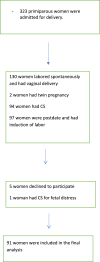Association between placental site and successful induction of labor among postdate primiparous women
- PMID: 39592471
- PMCID: PMC11919931
- DOI: 10.1007/s00404-024-07765-y
Association between placental site and successful induction of labor among postdate primiparous women
Abstract
Purpose: This study aimed to determine the association between placental site and successful labor induction.
Methods: This cross-sectional study recruited all postdate primiparous women undergoing induction of labor. Eligible women were subjected to proper history taking and clinical examination. Vaginal examination to determine the bishop score was done. Routine antenatal scan was done for fetal biometry and the placental site. Transvaginal ultrasound was done for cervical length assessment. Induction of labor was commenced and women were subdivided into those with successful induction (delivered vaginally) and those with failed induction (needed cesarean delivery).
Results: Successful induction was achieved in 73/91 (80.2%) participants. The bishop score was significantly increased among women with successful induction (4.6 ± 0.9 vs 3.9 ± 1.1, p value 0.014). In addition, the cervical length was significantly shorter among those who delivered vaginally (2.6 ± 0.5 vs 4.2 ± 0.5, p value 0.0001). There was no significant difference in the placental site among women with failed or successful induction. The cervical length was the only significant predictor for successful induction of labor (p value 0.0001). The placental site showed a non-significant role in the prediction of successful vaginal delivery (p value 0.280).
Conclusion: The placental site is not associated with the outcome of labor induction. The cervical length was the significant predictor for successful induction of labor.
Keywords: Failed induction; Induction of labor; Placental site; Postdate gestation; Primiparous; Vaginal delivery.
© 2024. The Author(s).
Conflict of interest statement
Declarations. Conflict of interest: None. Ethical approval and consent to participate: This study was conducted after approval of the research ethics committee of the faculty of medicine, Suez Canal University, on 15/11/2022 with a number of 5129#. All the procedures performed in the study were following the ethical standards of the institutional and/or national research committee and with the 1964 Helsinki declaration and its later amendments or comparable ethical standards. This article does not contain any studies with animals performed by any of the authors. Informed written consent was obtained from all participants before enrollment in the study.
References
-
- Martin JA, Hamilton BE, Sutton PD, Ventura SJ, Menacker F, Kirmeyer S et al (2009) National vital statistics reports. Natl Vital Stat Rep 57(7):1–102
-
- Coates D, Homer C, Wilson A, Deady L, Mason E, Foureur M, Henry A (2020) Induction of labour indications and timing: a systematic analysis of clinical guidelines. Women and Birth 33(3):219–230 - PubMed
-
- Ehrenthal DB, Jiang X, Strobino DM (2010) Labor induction and the risk of a cesarean delivery among nulliparous women at term. Obstet Gynecol 116(1):35–42 - PubMed
-
- Caughey AB, Sundaram V, Kaimal AJ, Gienger A, Cheng YW, McDonald KM et al (2009) Systematic review: elective induction of labor versus expectant management of pregnancy. Ann Intern Med 151(4):252–263 - PubMed
MeSH terms
LinkOut - more resources
Full Text Sources


